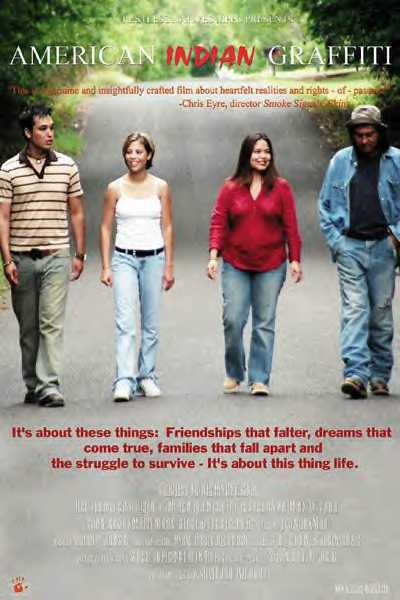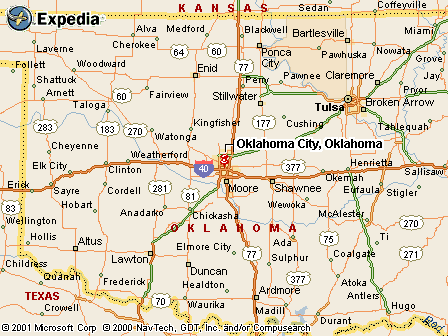|
|
Canku Ota |
|
|
(Many Paths) |
||
|
An Online Newsletter Celebrating Native America |
||
|
April 17, 2004 - Issue 111 |
||
|
|
||
|
"American Indian Graffiti" Debuts |
||
|
by Wilhelm Murg / Correspondent
/ Indian Country Today
|
||
|
credits: The
movie poster from 'American Indian Graffiti', a movie about Native
Americans in a contemporary setting. (Photo courtesy Restless Natives
Motion Picture Company)
|
|
Because the filmmakers have been in a rush to finish the project, "American Indian Graffiti" has only been shown in Oklahoma's "Bare Bones International Film Festival," where it won the Grand Jury Award. "The movie is about Native Americans in a contemporary setting," said co-director, co-writer, and co-star Steve Judd. "Kimberly Norris Guerrero, who was in 'Dreamkeeper' and 'Seinfeld' (in the cigar store Indian episode), flew in from Los Angeles to do a part in our film. Yvonne Russo, who helped produce 'Naturally Native,' Chris Freihofer, who was in 'O' and 'Eye of God,' the artist Richard Ray Whitman, and the rest of the leads are all American Indians from Oklahoma." The film is set in a fictional town and intertwines the stories of four individuals over a summer. Judd likens the structure to Paul Thomas Anderson's modern classic "Magnolia," where the separate stories slowly come together at the end of the narrative. He said that, like graffiti, it all becomes one big picture. "The main story is about two girls who graduated out of high school and, like a lot of people, they talk about going to California or New York when they graduate, but one of the girls decides she wants to work in the summer and go to school," Judd said. "The other girl, unbeknownst to her friend, is dying, and this will be her last trip so, they get into an argument about it. The mother and the twin sister of the girl that wants to go to school both died when she was born. The girl always wondered why she lived, but it turns out the secret everyone knew, but her, was that her mother tried to abort her. That part is about her coming to acceptance, and about the girls' friendship. "The other story, featuring Richard Ray Whitman in the lead, is about a mechanic who had a drunk driving accident when he was in his twenties that killed his wife and his son. His mother lived, but she doesn't want anything to do with him, so he's a loner, almost suicidal. One day a 7-year-old girl wanders into his shop, her mother didn't want to take care of her; she's always out with the guys. It's about the unlikely friendship between the girl and the man. "The third story is about an artist who, since he was a little kid, has never seen a blank canvas," Judd continued. "There was always a picture on every canvas he sees, so he paints over the pictures. He becomes famous and is about to become the next big thing, then all of the sudden he loses his artistic ability when he sees a blank canvas for the first time in his life, and it follows his downward spiral from there. The film goes back and forth from story to story; everyone is involved in each other's story." Judd wanted to make a movie that not only reflected American Indian life, but his own experience of growing up in Oklahoma, where Native culture is integrated into mainstream society. "When I was growing up I probably liked more mainstream films, while Tvli was really into foreign films and art films," Judd said. "When I a kid I saw 'Raiders of the Lost Ark' and I realized there was never a movie where I could see someone who looks like me. It's not that I couldn't identify with the film, I would go home and pretend to be Indiana Jones, but I could never say 'Wow! That could be me.' Tvli and I wanted to make movies that could star any nationality. Our movies are about Native Americans, but it doesn't focus on the phenomenon of being Native American. There are plenty of movies that do that, and I love them, but we wanted to get a different take on it. Also, most films about Native Americans are usually about some northern tribe out on the reservation. Of course, if you talk to Indians in Oklahoma, it's slightly different." "American Indian Graffiti" was shot on digital video and Judd described it as "a zero budget film." However, that will not be the case in his next project. "Smoke Signals" director Chris Eyre showed his film "Skins" at the University of Oklahoma, where Judd and Jacob managed to get a rough cut of their film to him. Eyre liked it and gave the young directors a quote for their poster. "If we were African-American, he would be like Spike Lee to me," Judd said. "He's the only director who has done anything that is known in the mainstream. He's like a brand name." Eyre is set to produce Restless Natives' next project, which will be an action movie. "'American Indian Graffiti' is not a movie for everyone," Judd said. "It's not artsy, in the sense that you'll see a cow walking out of the middle of nowhere, but it's artsy in that you would see it more in art theaters, because it is on digital video, and it's character driven. It's a slice of life. We shot the movie on the cheap, and it's pretty much for people who want to see a story, and we hope they like it and enjoy it. We did our best." To find out more and to download the trailer of the film, visit http://www.restless-natives.com. |
|
|
www.expedia.com |
|
|
||
|
|
||
| Canku Ota is a free Newsletter celebrating Native America, its traditions and accomplishments . We do not provide subscriber or visitor names to anyone. Some articles presented in Canku Ota may contain copyright material. We have received appropriate permissions for republishing any articles. Material appearing here is distributed without profit or monetary gain to those who have expressed an interest. This is in accordance with Title 17 U.S.C. Section 107. | ||
|
Canku Ota is a copyright © 2000, 2001, 2002, 2003, 2004 of Vicki Lockard and Paul Barry. |
||
 |
 |
|
|
The "Canku Ota - A Newsletter Celebrating Native America" web site and its design is the |
||
|
Copyright © 1999, 2000, 2001, 2002, 2003, 2004 of Paul C. Barry. |
||
|
All Rights Reserved. |
||
 OKLAHOMA
CITY - "American Indian Graffiti" is a new film written
and directed by Native Oklahomans Tvli Jacob, Choctaw, and Steve
Judd, Choctaw/Kiowa. The film premiered Feb. 20 at the Individual
Artists of Oklahoma Gallery in Oklahoma City, and it will also play
at Dakota State University in Madison, S.D. on April 15. The filmmakers
formed Restless Natives Motion Picture Company to make movies by,
about, for, and featuring American Indians. Their objective is to
show American Indian people in a realistic light.
OKLAHOMA
CITY - "American Indian Graffiti" is a new film written
and directed by Native Oklahomans Tvli Jacob, Choctaw, and Steve
Judd, Choctaw/Kiowa. The film premiered Feb. 20 at the Individual
Artists of Oklahoma Gallery in Oklahoma City, and it will also play
at Dakota State University in Madison, S.D. on April 15. The filmmakers
formed Restless Natives Motion Picture Company to make movies by,
about, for, and featuring American Indians. Their objective is to
show American Indian people in a realistic light.